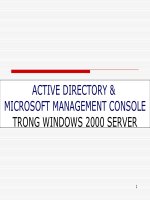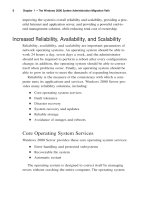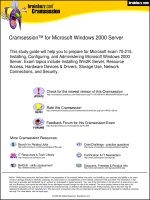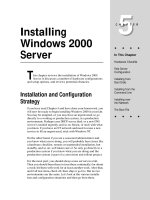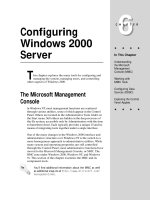hack proofing windows 2000 server
Bạn đang xem bản rút gọn của tài liệu. Xem và tải ngay bản đầy đủ của tài liệu tại đây (12.45 MB, 721 trang )
Your Complete Guide to Configuring a Secure Windows 2000 Network
• Complete Coverage of Internet Information Services (IIS) 5.0
• Hundreds of Configuring & Implementing,Designing & Planning Sidebars,
Security Alerts,and FAQs
• Complete Coverage of Kerberos, Distributed Security Services, and Public
Key Infrastructure
Chad Todd
Norris L. Johnson, Jr.
Technical Editor
From the authors
of the bestselling
HACK PROOFING
™
YOUR NETWORK
™
1YEAR UPGRADE
BUYER PROTECTION PLAN
From the authors
of the bestselling
HACK PROOFING
™
YOUR NETWORK
181_HPnew_FC 9/20/01 11:51 AM Page 1
www.sharexxx.net - free books & magazines
With more than 1,500,000 copies of our MCSE, MCSD, CompTIA, and Cisco
study guides in print, we continue to look for ways we can better serve the
information needs of our readers. One way we do that is by listening.
Readers like yourself have been telling us they want an Internet-based ser-
vice that would extend and enhance the value of our books. Based on
reader feedback and our own strategic plan, we have created a Web site
that we hope will exceed your expectations.
is an interactive treasure trove of useful infor-
mation focusing on our book topics and related technologies. The site
offers the following features:
■
One-year warranty against content obsolescence due to vendor
product upgrades. You can access online updates for any affected
chapters.
■
“Ask the Author”™ customer query forms that enable you to post
questions to our authors and editors.
■
Exclusive monthly mailings in which our experts provide answers to
reader queries and clear explanations of complex material.
■
Regularly updated links to sites specially selected by our editors for
readers desiring additional reliable information on key topics.
Best of all, the book you’re now holding is your key to this amazing site.
Just go to www.syngress.com/solutions, and keep this book handy when
you register to verify your purchase.
Thank you for giving us the opportunity to serve your needs. And be sure
to let us know if there’s anything else we can do to help you get the
maximum value from your investment. We’re listening.
www.syngress.com/solutions
181_SerSec2e_FM 9/20/01 1:07 PM Page i
181_SerSec2e_FM 9/20/01 1:07 PM Page ii
From the authors
of the bestselling
HACK PROOFING
™
YOUR NETWORK
™
1YEAR UPGRADE
BUYER PROTECTION PLAN
From the authors
of the bestselling
HACK PROOFING
™
YOUR NETWORK
Chad Todd
Norris L. Johnson, Jr.
Technical Editor
181_SerSec2e_FM 9/20/01 1:07 PM Page iii
Syngress Publishing, Inc., the author(s), and any person or firm involved in the writing, editing, or production
(collectively “Makers”) of this book (“the Work”) do not guarantee or warrant the results to be obtained from
the Work.
There is no guarantee of any kind, expressed or implied, regarding the Work or its contents.The Work is sold
AS IS and WITHOUT WARRANTY. You may have other legal rights, which vary from state to state.
In no event will Makers be liable to you for damages, including any loss of profits, lost savings, or other
incidental or consequential damages arising out from the Work or its contents. Because some states do not
allow the exclusion or limitation of liability for consequential or incidental damages, the above limitation may
not apply to you.
You should always use reasonable care, including backup and other appropriate precautions, when working
with computers, networks, data, and files.
Syngress Media®, Syngress®, and “Career Advancement Through Skill Enhancement®,” are registered
trademarks of Syngress Media, Inc. “Ask the Author™,” “Ask the Author UPDATE™,” “Mission Critical™,”
“Hack Proofing™,” and “The Only Way to Stop a Hacker is to Think Like One™” are trademarks of Syngress
Publishing, Inc. Brands and product names mentioned in this book are trademarks or service marks of their
respective companies.
KEY SERIAL NUMBER
001 AJNR2U394F
002 BKAER9325R
003 ZLKRT9BSW4
004 VKF95TMKMD
005 BWE9SD4565
006 CAL44GMLSA
007 XD2KLFW3RM
008 QM4VLR39P6
009 5MVREM56PK
010 9VNLA2MER3
PUBLISHED BY
Syngress Publishing, Inc.
800 Hingham Street
Rockland, MA 02370
Hack Proofing Windows 2000
Copyright © 2001 by Syngress Publishing, Inc.All rights reserved. Printed in the United States of America.
Except as permitted under the Copyright Act of 1976, no part of this publication may be reproduced or
distributed in any form or by any means, or stored in a database or retrieval system, without the prior written
permission of the publisher, with the exception that the program listings may be entered, stored, and executed
in a computer system, but they may not be reproduced for publication.
Printed in the United States of America
1 2 3 4 5 6 7 8 9 0
ISBN: 1-931836-49-3
Technical Editor: Norris L. Johnson, Jr. Cover Designer: Michael Kavish
Co-Publisher: Richard Kristof Page Layout and Art by: Shannon Tozier
Acquisitions Editor: Catherine B. Nolan Copy Editor: Darlene Bordwell
Developmental Editor: Jonathan Babcok Indexer: Robert Saigh
Freelance Editorial Manager: Maribeth Corona-Evans
Distributed by Publishers Group West in the United States and Jaguar Book Group in Canada.
181_SerSec2e_FM 9/20/01 1:07 PM Page iv
v
Acknowledgments
v
We would like to acknowledge the following people for their kindness and support
in making this book possible.
Richard Kristof and Duncan Anderson of Global Knowledge, for their generous
access to the IT industry’s best courses, instructors, and training facilities.
Ralph Troupe, Rhonda St. John, and the team at Callisma for their invaluable insight
into the challenges of designing, deploying and supporting world-class enterprise
networks.
Karen Cross, Lance Tilford, Meaghan Cunningham, Kim Wylie, Harry Kirchner,
Kevin Votel, Kent Anderson, Eric Green, Dave Dahl, Elise Cannon, Chris Barnard,
John Hofstetter, and Frida Yara of Publishers Group West for sharing their incredible
marketing experience and expertise. In addition, a special thanks to Janis Carpenter,
Kimberly Vanderheiden, and all of the PGW Reno staff for help on recent projects.
Mary Ging, Caroline Hird, Simon Beale, Caroline Wheeler,Victoria Fuller, Jonathan
Bunkell, and Klaus Beran of Harcourt International for making certain that our
vision remains worldwide in scope.
Anneke Baeten and Annabel Dent of Harcourt Australia for all their help.
David Buckland,Wendi Wong, Daniel Loh, Marie Chieng, Lucy Chong, Leslie Lim,
Audrey Gan, and Joseph Chan of Transquest Publishers for the enthusiasm with
which they receive our books.
Kwon Sung June at Acorn Publishing for his support.
Ethan Atkin at Cranbury International for his help in expanding the Syngress
program.
Joe Pisco, Helen Moyer, Paul Zanoli,Alan Steele, and the great folks at
Graphic Services/InterCity Press for all their help.
181_SerSec2e_FM 9/20/01 1:07 PM Page v
From the Author
I would like to thank Paul Salas, coauthor of Administering Cisco QOS for IP Networks
by Syngress Publishing, for introducing me to the folks at Syngress and Chris Jackson
for his support and encouragement. I would also like to thank the authors of
Configuring Windows 2000 Server Security, Thomas Shinder, Debra Shinder, and Lynn
White, for providing the foundation for this book. Finally, a thank you to the editors
that made this book possible—Jon Babcock, Catherine Nolan, Norris Johnson,
Thomas Llewellyn, and Melissa Craft.
I would also like to thank my wife Sarah who is a tremendous help in my work
and supportive of the numerous hours spent on my various projects.Without Sarah’s
loving support, I would not be able to accomplish my personal or professional goals.
181_SerSec2e_FM 9/20/01 1:07 PM Page vi
vii
Author
Chad Todd (MCSE, MCT, CNE, CNA, A+, Network+, i-Net+) is a
Systems Trainer for Ikon Education Services, a global provider of tech-
nical training. He currently teaches Windows 2000 Security classes. In
addition to training for Ikon, Chad also provides private consulting for
small- to medium-sized companies. Chad writes practice tests for Boson
Software and is the coauthor of Test 70-227: Installing, Configuring, and
Administering Microsoft Internet Security and Acceleration (ISA) Server
2000, Enterprise Edition. Chad first earned his MCSE on Windows NT
4.0 and has been working with Windows 2000 since its first beta release.
He was awarded Microsoft Charter Member 2000 for being one of the
first 2000 engineers to attain Windows 2000 MCSE certification. Chad
lives in Columbia, SC with his wife Sarah.
Norris L. Johnson, Jr. (MCSE, MCT, CTT,A+, Network +) is a
Technology Trainer and Owner of a consulting company in the Seattle-
Tacoma area. His consultancies have included deployments and security
planning for local firms and public agencies. He specializes in Windows NT
4.0 and Windows 2000 issues, providing planning and implementation and
integration services. In addition to consulting work, Norris is a Trainer for
the AATP program at Highline Community College’s Federal Way,WA
campus and has taught in the vocational education arena at Bates Technical
College in Tacoma,WA. Norris holds a bachelor’s degree from Washington
State University. He is deeply appreciative of the guidance and support pro-
vided by his parents and wife Cindy while transitioning to a career in
Information Technology.
Technical Editor
181_SerSec2e_FM 9/20/01 1:07 PM Page vii
viii
Contributors
Dr.Thomas W. Shinder, M.D. (MCSE, MCP+I, MCT) is a Technology
Trainer and Consultant in the Dallas-Ft.Worth metroplex. He has consulted
with major firms, including Xerox, Lucent Technologies, and FINA Oil,
assisting in the development and implementation of IP-based communica-
tions strategies.Tom is a Windows 2000 editor for Brainbuzz.com, a
Windows 2000 columnist for Swynk.com, and is the author of Syngress’s
bestselling Configuring ISA Server 2000 (1-928994-29-6).
Tom attended medical school at the University of Illinois in Chicago
and trained in neurology at the Oregon Health Sciences Center in
Portland, OR. His fascination with interneuronal communication ulti-
mately melded with his interest in internetworking and led him to focus
on systems engineering.Tom and his wife, Debra Littlejohn Shinder,
design elegant and cost-efficient solutions for small- and medium-sized
businesses based on Windows NT/2000 platforms.Tom has contributed
to several Syngress titles, including Configuring Windows 2000 Server
Security (ISBN: 1-928994-02-4), and Managing Windows 2000 Network
Services (ISBN: 1-928994-06-7), and is the coauthor of Troubleshooting
Windows 2000 TCP/IP (1-928994-11-3).
Debra Littlejohn Shinder (MCSE, MCT, MCP+I), is an Independent
Technology Trainer,Author, and Consultant who works in conjunction
with her husband, Dr.Thomas Shinder, in the Dallas-Ft.Worth area. She
has been an instructor in the Dallas County Community College District
since 1992, and is the Webmaster for the cities of Seagoville and
Sunnyvale,TX.
Deb is a featured Windows 2000 columnist for Brainbuzz.com
and a regular contributor to TechRepublic’s TechProGuild. She and
Tom have authored numerous online courses for DigitalThink
(www.digitalthink.com) and have given presentations at technical confer-
ences on Microsoft certification and Windows NT and 2000 topics. Deb
is also the Series Editor for the Syngress/Osborne McGraw-Hill
181_SerSec2e_FM 9/20/01 1:07 PM Page viii
ix
Windows 20000 MCSE study guides. She is a member of the Author’s
Guild, the IEEE IPv6 Task Force, and local professional organizations.
Deb and Tom met online and married in 1994.They opened a net-
working consulting business and developed the curriculum for the MCSE
training program at Eastfield College before becoming full-time tech-
nology writers. Deb is the coauthor of Syngress’s bestselling Configuring
ISA Server 2000 (1-928994-29-6). She has also coauthored Syngress’s
Troubleshooting Windows 2000 TCP/IP (ISBN: 1-928994-11-3) and has
contributed to several Syngress titles, including Managing Windows 2000
Network Services (ISBN: 1-928994-06-7) and Configuring Windows 2000
Server Security (ISBN: 1-928994-02-4).
Stace Cunningham (CMISS, CCNA, MCSE, CLSE, COS/2E, CLSI,
COS/2I, CLSA, MCPS,A+) is a Security Consultant. He has assisted sev-
eral clients, including a casino, in the development and implementation of
network security plans for their organizations. He has held the positions
of Network Security Officer and Computer Systems Security Officer
while serving in the United States Air Force.
While in the Air Force, Stace was also heavily involved for over 14
years in installing, troubleshooting, and protecting long-haul circuits with
the appropriate level of cryptography necessary to protect the level of
information traversing the circuit as well as protecting the circuits from
TEMPEST hazards.This not only included American equipment but also
equipment from Britain and Germany while he was assigned to Allied
Forces Southern Europe (NATO).
Stace was an active contributor to The SANS Institute booklet
“Windows NT Security Step by Step.” In addition, he has coauthored over
18 books published by Osborne/McGraw-Hill, Syngress Media, and
Microsoft Press. He has also performed as Technical Editor for various other
books and is a published author in Internet Security Advisor magazine.
His wife Martha and daughter Marissa are very supportive of the time
he spends with his computers, routers, and firewalls in the “lab” of their
house.Without their love and support he would not be able to accomplish
the goals he has set for himself.
181_SerSec2e_FM 9/20/01 1:07 PM Page ix
x
D. Lynn White (MCPS, MCSE, MCT, MCP+Internet, CTT) is
President of Independent Network Consultants, Inc. Lynn has more than
15 years in programming and networking experience. She has been a
system manager in the mainframe environment, as well as a software
developer for a process control company. She is a technical author, editor,
trainer, and consultant in the field of networking and computer-related
technologies. Lynn has been presenting mainframe, Microsoft official cur-
riculum and other operating systems and networking courses in and out-
side the United States for more than 13 years. Lynn is the Series Editor
for Syngress for both the Network+ and A+ Series. Her latest certifica-
tion has been to receive her CTT (Certified Technical Trainer) by the
Chauncey Group International. Lynn would like to extend thanks to her
family and friends for always being there over the years.
Brian M. Collins (MCNE, MCSE, MCT, CTT) is a Technical Trainer
for Network Appliance, Inc. in Sunnyvale, CA.A Technology Industry
veteran of 20 years, his employment background includes US Navy
Electronics, Semiconductor Industry Robotics, Software Development in
several languages, and System Administration. Brian’s hobbies include
hiking, operating systems, and coding.When not traveling the world
training for NetApp, Brian can be found in the Santa Cruz Mountains of
California, 30 miles from the center of Silicon Valley.
Garrick Olsen (A+, Network+, MCP+I, MCSE+I, CNE) currently
works for MicroAge in Anchorage,AL as a Network Technician.
181_SerSec2e_FM 9/20/01 1:07 PM Page x
Contents
xi
Chapter 1 The Windows 2000
Server Security Migration Path 1
Introduction 2
Windows 2000 Server Security 3
Why the Change? 3
Differences in Windows 2000 Server Security 4
Authentication Limitations 7
What Is the Same in Windows 2000 Server? 9
Upgrading and Migrating Considerations 9
Network Security Plan 9
How to Begin the Process 11
Getting Started 12
Exercise 1.1 Switching to Native Mode 13
Issues to Present to Your Manager 15
Proper Analysis 16
Timing 16
Cost 16
Resources 17
Summary 18
Solutions Fast Track 18
Frequently Asked Questions 19
Chapter 2 Default Access Control Settings 21
Introduction 22
The Administrators Group 23
The Users Group 24
The Power Users Group 24
Answers to Your
Frequently Asked
Questions
Q: How can I enable my
Windows 98 clients to
use Kerberos v5
authentication?
A: Down-level clients
(Windows 9x and NT
4.0) do not support
Kerberos v5
authentication. The
only way to use
Kerberos would be to
upgrade your
Windows 98 clients to
Windows 2000
Professional.
181_SerSec2e_TOC 9/20/01 1:10 PM Page xi
xii Contents
Configuring Security during
Windows 2000 Setup 25
Default File System and Registry Permissions 30
Default User Rights 46
Exercise 2.1 Checking User Rights
through the Microsoft Management
Console 50
Default Group Membership 55
Pre-Windows 2000 Security 57
Summary 58
Solutions Fast Track 58
Frequently Asked Questions 60
Chapter 3 Kerberos Server Authentication 63
Introduction 64
Authentication in Windows 2000 64
Benefits of Kerberos Authentication 66
Standards for Kerberos Authentication 66
Extensions to the Kerberos Protocol 67
Overview of the Kerberos Protocol 67
Basic Concepts 67
Authenticators 68
Key Distribution Center 69
Session Tickets 69
Ticket-Granting Tickets 71
Services Provided by the Key
Distribution Center 72
Subprotocols 73
AS Exchange 73
TGS Exchange 75
CS Exchange 76
Option Flags for KRB_AS_REQ
and KRB_TGS_REQ Messages 77
Tickets 78
Proxy Tickets and Forwarded Tickets 81
Kerberos and Windows 2000 82
Key Distribution Center 84
Provides Details on
the Subprotocols
Kerberos contains three
subprotocols, also known
as exchanges:
■
Authentication Service
(AS) Exchange
■
Ticket-Granting Service
(TGS) Exchange
■
Client/Server (CS)
Exchange
181_SerSec2e_TOC 9/20/01 1:10 PM Page xii
Contents xiii
Kerberos Policy 86
Contents of a Microsoft Kerberos Ticket 88
Delegation of Authentication 88
Preauthentication 89
Security Support Providers 89
Credentials Cache 90
DNS Name Resolution 90
UDP and TCP Ports 91
Authorization Data 92
KDC and Authorization Data 92
Services and Authorization Data 92
Kerberos Tools 92
Kerberos List 93
Kerberos Tray 96
Summary 100
Solutions Fast Track 101
Frequently Asked Questions 103
Chapter 4 Secure Networking
Using Windows 2000 Distributed
Security Services 105
Introduction 106
The Way We Were: Security in NT 106
A Whole New World: Distributed
Security in Windows 2000 106
Distributed Services 107
Open Standards 107
Windows 2000 Distributed Security Services 109
Active Directory and Security 110
Advantages of Active Directory Account
Management 111
Managing Security via Object Properties 113
Managing Security via Group
Memberships 115
Active Directory Object Permissions 115
Exercise 4.1 Assigning Active Directory
Permissions to a Directory Object 116
Learn About Setting
Up Secure
Communication
with Multiple
Vendors via SSO
UNIX
Novell
MacIntosh
Other
Windows 3.x
Windows 95
Windows 98
Windows NT
Windows
2000
Kerberos
Web Clients
Mainframe
(AS/400)
SSL
SNA
Lan Manager
NTLM
181_SerSec2e_TOC 9/20/01 1:10 PM Page xiii
xiv Contents
Relationship between
Directory and Security Services 119
Active Directory Components 120
Exercise 4.2 Creating Trusts with
Active Directory Domains and Trusts 126
Delegation of Administration 128
Fine-Grain Access Rights 131
Inheritance of Access Rights 131
Security Protocols 134
NTLM Credentials 134
Kerberos Credentials 135
Getting a Ticket to Ride 136
Private and Public Key Pairs and Certificates 137
Other Supported Protocols 137
Internet Single Sign-On 138
Internet Security for Windows 2000 139
Client Authentication with SSL 3.0 140
Authentication of External Users 140
Microsoft Certificate Server 140
CryptoAPI 141
Interbusiness Access: Distributed Partnership 141
Summary 143
Solutions Fast Track 144
Frequently Asked Questions 147
Chapter 5 Security Configuration Tool Set 149
Introduction 150
Security Configuration Tool Set 150
Security Configuration Tool Set Components 151
Security Configuration and Analysis
Snap-In 151
Security Setting Extensions to Group
Policy 151
Security Templates 152
The Secedit.exe Command-Line Tool 154
Security Configurations 154
Security Configuration and Analysis Database 154
181_SerSec2e_TOC 9/20/01 1:10 PM Page xiv
Contents xv
Security Configuration and Analysis Areas 156
Account Policies 157
Local Policies 158
Event Log 158
Restricted Groups 158
System Services 158
Registry 158
File System 158
Security Configuration Tool Set User
Interfaces 159
Security Configuration and Analysis
Snap-In 159
The Secedit.exe Command-Line
Interface 161
Configuring Security 165
Account Policies 165
Local Policies 168
Event Log 174
Restricted Groups 176
Exercise 5.1 Configuring Restricted
Groups 177
Registry Security 179
Exercise 5.2 Configuring Registry
Security 179
File System Security 181
Exercise 5.3 Configuring File System
Security 181
System Services Security 184
Exercise 5.4 Configuring System Services
Security 185
Analyzing Security 186
Exercise 5.5 Analyzing the Local
Machine 186
Account and Local Policies 188
Restricted Group Management 188
Registry Security 188
Understand the
Secedit.exe Command
The secedit.exe command-
line interface allows the
administrator to:
■
Analyze system security
■
Configure system
security
■
Refresh security
settings
■
Export security settings
■
Validate the syntax of a
security template
181_SerSec2e_TOC 9/20/01 1:10 PM Page xv
xvi Contents
File System Security 189
System Services Security 190
Group Policy Integration 191
Security Configuration in Group Policy
Objects 191
The Security Settings Extension
to the Group Policy Editor 191
Additional Security Policies 193
Summary 194
Solutions Fast Track 195
Frequently Asked Questions 197
Chapter 6 Encrypting the File System
for Windows 2000 199
Introduction 200
Using the Encrypting File System 201
Encryption Fundamentals 201
How EFS Works 203
User Operations 204
File Encryption 205
Assessing an Encrypted File 207
Copying an Encrypted File 208
The Copy Command 209
Moving or Renaming an Encrypted File 209
Decrypting a File 210
Cipher Utility 211
Directory Encryption 212
Recovery Operations 213
Exercise 6.1 Configuring a Recovery
Agent without an EFS Certificate 213
Exercise 6.2 Adding a Recovery Agent
That Has an EFS Recovery Certificate 218
EFS Architecture 221
EFS Components 222
The Encryption Process 224
The EFS File Information 227
The Decryption Process 229
Learn the Syntax for
the EfsRecvr
Command Line
Item Function
/S Recovers the
files in the
given directory
and all subdi-
rectories. The
default direc-
tory is the
current
directory.
/I The recovery
process will
continue, even
if an error
occurs. The
default behavior
is to immedi-
ately stop the
recovery process
should an error
occur.
/Q Limits the
reporting of
only essential
information
needed to load
the appropriate
keys.
Filename Specifies a file,
directory, or
pattern.
181_SerSec2e_TOC 9/20/01 1:10 PM Page xvi
Contents xvii
Summary 232
Solutions Fast Track 233
Frequently Asked Questions 235
Chapter 7 IP Security for Microsoft
Windows 2000 Server 239
Introduction 240
Network Encroachment Methodologies 240
Snooping 241
Spoofing 241
The TCP/IP Sequence Number Attack 241
Password Compromise 242
Denial-of-Service Attacks 242
TCP SYN Attacks 243
SMURF Attacks 243
Teardrop Attacks 244
Ping of Death 244
Man-in-the-Middle Attacks 244
Application-Directed Attacks 245
Compromised Key Attacks 245
IPSec Architecture 246
Overview of IPSec Cryptographic Services 247
Message Integrity 247
Message Authentication 249
Confidentiality 251
IPSec Security Services 252
The Authentication Header 252
Encapsulating Security Payload 253
Security Associations and IPSec
Key Management Procedures 254
IPSec Key Management 255
Deploying Windows IP Security 256
Evaluating Information 256
Evaluating the “Enemy” 257
Determining Required Security Levels 258
Building Security Policies with
Customized IPSec Consoles 259
Implement IPSec
Security Services
IPSec engages two
protocols to implement
security on an IP network:
■
Authentication header
(AH)
■
Encapsulating security
protocol (ESP)
181_SerSec2e_TOC 9/20/01 1:10 PM Page xvii
xviii Contents
Exercise 7.1 Building an IPSec MMC
Console 259
Flexible Security Policies 261
Rules 263
Flexible Negotiation Policies 267
Filters 268
Creating a Security Policy 269
Making the Rule 271
Compatibility Notes 283
Summary 284
Solutions Fast Track 285
Frequently Asked Questions 287
Chapter 8 Smart Cards 289
Introduction 290
Interoperability 291
ISO 7816, EMV, and GSM 291
The PC/SC Workgroup 292
The Microsoft Approach 292
A Standard Model for Interfacing Smart
Card Readers and Cards with PCs 293
Device-Independent APIs for Enabling
Smart Card-Aware Applications 294
Integration with Various Microsoft
Platforms 295
Smart Card Base Components 296
Service Providers 296
Cryptographic Service Providers 296
Smart Card Service Providers 296
Cards 297
Resource Manager 300
Enhanced Solutions 302
Client Authentication 302
Public Key Interactive Logon 302
Smart Card Reader Installation 303
Smart Card Certificate Enrollment 305
Smart Card Logon 309
Learn About the
Interaction between a
Smart Card
Application and a
Smart Card Reader
Smart Card-Aware
Application
Smart Card
Service Providers
Smart Card
Resource Manager
Smart Card Reader
Driver/Handler
Smart Card Reader
Driver/Handler
RS-232 PS/2 PCMCIA
Smart Card
Reader
Smart Card
(ICC)
Smart Card Reader
Driver/Handler
Smart Card
Reader
Smart Card
Reader
Smart Card
(ICC)
Smart Card
(ICC)
181_SerSec2e_TOC 9/20/01 1:10 PM Page xviii
Contents xix
Secure E-Mail 309
Summary 311
Solutions Fast Track 311
Frequently Asked Questions 313
Chapter 9 Microsoft Windows 2000
Public Key Infrastructure 315
Introduction 316
Concepts 316
Public Key Cryptography 317
Public Key Functionality 319
Digital Signatures 319
Authentication 321
Secret Key Agreement via Public Key 322
Bulk Data Encryption without Prior
Shared Secrets 322
Protecting and Trusting Cryptographic Keys 323
Certificates 323
Certificate Authorities 324
Certificate Types 325
Trust and Validation 326
Windows 2000 PKI Components 328
Certificate Authorities 329
Certificate Hierarchies 330
Deploying an Enterprise CA 331
Trust in Multiple CA Hierarchies 332
Installing a Windows 2000 PKI 333
Exercise 9.1 Installing Certificate
Services 334
Enabling Domain Clients 338
Generating Keys 338
Key Recovery 338
Exercise 9.2 Exporting a Certificate and
a Private Key 339
Certificate Enrollment 343
Learn About Why
Certificates Can Be
Revoked
Any of these
circumstances would
certainly warrant the
revoking of a certificate:
■
An entity’s private key
has been
compromised.
■
A project with another
organization is
completed.
■
The employee has
changed status within
the company.
■
A department is to
cease having access to
certain information.
■
The certificate was
obtained through
forgery.
181_SerSec2e_TOC 9/20/01 1:10 PM Page xix
xx Contents
Exercise 9.3 Requesting a User
Certificate with the Certificate
Request Wizard 343
Exercise 9.4 Requesting an EFS
Recovery Agent Certificate from the
CA Web Page 348
Renewal 352
Using Keys and Certificates 352
Roaming 353
Revocation 354
Exercise 9.5 Revoking a Certificate and
Publishing a CRL 355
Trust 356
Exercise 9.6 Importing a Certificate
from a Trusted Root CA 357
Public Key Security Policy in Windows 2000 361
Trusted CA Roots 361
Exercise 9.7 Configuring Automatic
Certificate Enrollment through
Group Policy 363
Certificate Enrollment and Renewal 366
Exercise 9.8 Changing the Templates
Available on the Enterprise
Certification Authority 368
Smart Card Logon 369
Applications Overview 369
Web Security 370
Secure E-Mail 370
Digitally Signed Content 371
Encrypting File System 373
Smart-Card Logon 373
IP Security 374
Preparing for Windows 2000 PKI 375
Backing Up and Restoring Certificate Services 377
Exercise 9.9 Backing Up Certificate
Services 377
181_SerSec2e_TOC 9/20/01 1:10 PM Page xx
Contents xxi
Exercise 9.10 Restoring Certificate
Services 379
Summary 383
Solutions Fast Track 385
Frequently Asked Questions 389
Chapter 10 Supporting
Non-Windows 2000 Clients and Servers 393
Introduction 394
Authenticating Down-Level Clients 394
Defining Lan Manager and NT
Lan Manager Authentication 395
Using the Directory Services Client 396
Deploying NTLM Version 2 397
Configuring the Servers to Require
NTLMv2 397
Making the Clients Use NTLMv2 400
Exercise 10.1 Configuring Windows
NT 4.0 Clients to Use NTLMv2 400
Exercise 10.2 Configuring Windows
9x Clients to Use NTLMv2 401
Working with UNIX Clients 402
Installing Services for UNIX 403
Exercise 10.3 Adding a User
to the Schema Admin Group 404
Exercise 10.4 Enabling the Schema
Master for Write Operation 406
Exercise 10.5 Installing Services for
UNIX 411
NFS Software 418
Using the Client Software for NFS 418
Using the Server Software for NFS 420
Using the Gateway Software for NFS 422
Using the PCNFS Server Software
for NFS 422
Account Administration Tools 424
Network Administration Tools 432
Authenticating Down-
Level Clients
Microsoft considers all
clients running any
Microsoft operating
system (OS) other than
Windows 2000 to be
down-level clients. In
Chapter 10, we focus on
the following operating
systems:
■
Windows 95
■
Windows 98
■
Windows NT 4.0
181_SerSec2e_TOC 9/20/01 1:10 PM Page xxi
xxii Contents
Using the UNIX Utilities 435
Authenticating UNIX Clients 438
Working with Novell Clients 439
Client Services for NetWare 441
Gateway Services for NetWare 441
Exercise 10.6 Installing Gateway Services
for NetWare 442
Exercise 10.7 Configuring
Gateway Services for NetWare 445
Understanding Services for NetWare 447
Exercise 10.8 Installing Services for
NetWare 447
Using Microsoft Directory
Synchronization Services 452
Using the Microsoft File Migration
Utility 453
Using File and Print Services for
NetWare 460
Understanding the Security Risk
Associated With Accessing NetWare
Computers 460
Working with Macintosh Clients 462
Understanding Files Services for Macintosh 462
Understanding Print Services for Macintosh 463
Installing File and Print Services for
Macintosh 463
Authenticating Macintosh Clients 464
Summary 465
Solutions Fast Track 467
Frequently Asked Questions 468
Chapter 11 Securing Internet
Information Services 5.0 471
Introduction 472
Securing the Windows 2000 Server 473
Installing Internet Information Services 5.0 475
181_SerSec2e_TOC 9/20/01 1:10 PM Page xxii
Contents xxiii
Exercise 11.1 Uninstalling IIS 5.0 476
Exercise 11.2 Creating an
Answer File for Installing IIS 480
Securing Internet Information Services 5.0 481
Setting Web Site, FTP Site, and Folder
Permissions 481
Configuring Web Site Permissions 482
Configure FTP Site Permissions 484
Exercise 11.3 Setting FTP Site
Permissions 485
Configuring NTFS Permissions 485
Using the Permissions Wizard 487
Using the Permission Wizard Template
Maker 490
Restricting Access through IP Address
and Domain Name Blocking 495
Configuring Authentication 497
Configuring Web Site Authentication 505
Exercise 11.4 Selecting the Level of
Authentication Supported 505
Configuring FTP Site Authentication 509
Exercise 11.5 Setting FTP Authentication 510
Examining the IIS Security Tools 511
Using the Hotfix Checking Tool for IIS 5.0 511
Using the IIS Security Planning Tool 513
Using the Windows 2000 Internet Server
Security Configuration Tool for IIS 5.0 514
The Interviewing Process 515
Configuring the Template Files 515
Deploying the Template Files 524
Auditing IIS 526
Exercise 11.6 Configuring Auditing
for an Organizational Unit 527
Summary 529
Solutions Fast Track 530
Frequently Asked Questions 533
Learn the NTFS
Permissions
■
Full Control
■
Modify
■
Read and Execute
■
List Folder Contents
■
Read
■
Write
181_SerSec2e_TOC 9/20/01 1:10 PM Page xxiii
xxiv Contents
Chapter 12 Using Security-Related Tools 535
Introduction 536
Installing the Support Tools 536
Exercise 12.1 Installing the Support
Tools 537
Installing the Windows 2000 Server
Resource Kit 540
Exercise 12.2 Installing the
Windows 2000 Server Resource Kit 540
Using Application Tools 544
Using the Application Security Tool 545
Installing the Application Security Tool 546
Running the Applications as Services Utility 546
Installing Srvany 547
Exercise 12.3 Using Srvany 547
Exercise 12.4 Using the Service
Installation Wizard 547
Configuring an Application to Run
as a Service 552
Exercise 12.5 Configuring the Registry
to Run Applications as Services 553
Using Service Tools 556
Running the Service Controller Tool 556
Using ScList 558
Using the Service Monitoring Tool 561
Exercise 12.6 Running the Service
Monitor Configuration Wizard 561
Using Registry Tools 564
Using Registry Backup 564
Using Registry Restoration 565
Running the Registry Console Tool 566
Using Process Tools 569
Running the Process Viewer 570
Running the Task List Viewer 571
Using the Task Killing Utility 573
Using Process Tree 573
Exercise 12.7 Installing Process Tree 575
Use the Service
Monitoring Tool
The Service Monitoring
tool (svcmon) monitors
when services are started
or stopped. Svcmon works
locally and remotely. It will
send you an e-mail when
a service is changed.
Svcmon polls the services
every 10 minutes to
determine that they are in
the same state as they
were in the previous poll.
181_SerSec2e_TOC 9/20/01 1:10 PM Page xxiv

